Entry Database : PDB / ID : 5ycoTitle Complex structure of PCNA with UHRF2 E3 ubiquitin-protein ligase UHRF2 Proliferating cell nuclear antigen Keywords / / / Function / homology Function Domain/homology Component
/ / / / / / / / / / / / / / / / / / / / / / / / / / / / / / / / / / / / / / / / / / / / / / / / / / / / / / / / / / / / / / / / / / / / / / / / / / / / / / / / / / / / / / / / / / / / / / / / / / / / / / / / / / / / / / / / / / / / / / / / / / / / / / / / / / / / / / / / / / / / / / / / / / / / / / / / / / / / Biological species Homo sapiens (human)Method / / / / Resolution : 2.199 Å Authors Wu, M. / Chen, W. / Hang, T. / Wang, C. / Zhang, X. / Zang, J. Funding support Organization Grant number Country National Key Research and Development Program of China 2016YFA0400903, 2017YFA0503600 National Natural Science Foundation of China U1532109, 31370756, and 31361163002
Journal : Biochem. Biophys. Res. Commun. / Year : 2017Title : Structure insights into the molecular mechanism of the interaction between UHRF2 and PCNA.Authors : Chen, W. / Wu, M. / Hang, T. / Wang, C. / Zhang, X. / Zang, J. History Deposition Sep 7, 2017 Deposition site / Processing site Revision 1.0 Nov 15, 2017 Provider / Type Revision 1.1 Dec 6, 2017 Group / Category Item / _citation.page_first / _citation.page_lastRevision 1.2 Nov 22, 2023 Group / Database references / Refinement descriptionCategory chem_comp_atom / chem_comp_bond ... chem_comp_atom / chem_comp_bond / database_2 / pdbx_initial_refinement_model Item / _database_2.pdbx_database_accessionRevision 1.3 Sep 17, 2025 Group / Derived calculations / Structure summaryCategory pdbx_entry_details / pdbx_modification_feature ... pdbx_entry_details / pdbx_modification_feature / pdbx_validate_close_contact / struct_conn / struct_conn_type
Show all Show less
 Open data
Open data Basic information
Basic information Components
Components Keywords
Keywords Function and homology information
Function and homology information Homo sapiens (human)
Homo sapiens (human) X-RAY DIFFRACTION /
X-RAY DIFFRACTION /  SYNCHROTRON /
SYNCHROTRON /  MOLECULAR REPLACEMENT /
MOLECULAR REPLACEMENT /  molecular replacement / Resolution: 2.199 Å
molecular replacement / Resolution: 2.199 Å  Authors
Authors China, 2items
China, 2items  Citation
Citation Journal: Biochem. Biophys. Res. Commun. / Year: 2017
Journal: Biochem. Biophys. Res. Commun. / Year: 2017 Structure visualization
Structure visualization Molmil
Molmil Jmol/JSmol
Jmol/JSmol Downloads & links
Downloads & links Download
Download 5yco.cif.gz
5yco.cif.gz PDBx/mmCIF format
PDBx/mmCIF format pdb5yco.ent.gz
pdb5yco.ent.gz PDB format
PDB format 5yco.json.gz
5yco.json.gz PDBx/mmJSON format
PDBx/mmJSON format Other downloads
Other downloads 5yco_validation.pdf.gz
5yco_validation.pdf.gz wwPDB validaton report
wwPDB validaton report 5yco_full_validation.pdf.gz
5yco_full_validation.pdf.gz 5yco_validation.xml.gz
5yco_validation.xml.gz 5yco_validation.cif.gz
5yco_validation.cif.gz https://data.pdbj.org/pub/pdb/validation_reports/yc/5yco
https://data.pdbj.org/pub/pdb/validation_reports/yc/5yco ftp://data.pdbj.org/pub/pdb/validation_reports/yc/5yco
ftp://data.pdbj.org/pub/pdb/validation_reports/yc/5yco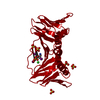
 Links
Links Assembly
Assembly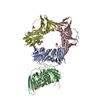
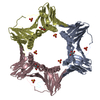
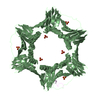
 Components
Components Homo sapiens (human) / Gene: PCNA / Production host:
Homo sapiens (human) / Gene: PCNA / Production host: 
 Homo sapiens (human)
Homo sapiens (human) X-RAY DIFFRACTION / Number of used crystals: 1
X-RAY DIFFRACTION / Number of used crystals: 1  Sample preparation
Sample preparation SYNCHROTRON / Site:
SYNCHROTRON / Site:  SSRF
SSRF  / Beamline: BL17U1 / Wavelength: 0.9791 Å
/ Beamline: BL17U1 / Wavelength: 0.9791 Å molecular replacement
molecular replacement Processing
Processing MOLECULAR REPLACEMENT
MOLECULAR REPLACEMENT Movie
Movie Controller
Controller



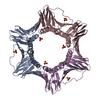



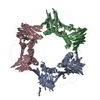

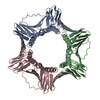
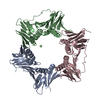
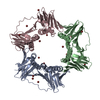
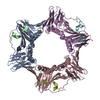

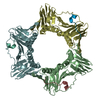
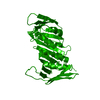

 PDBj
PDBj























